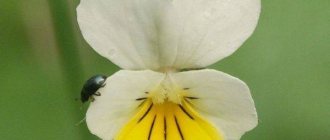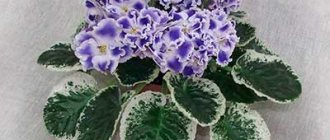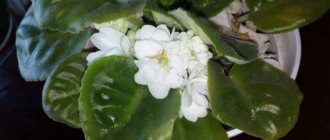It is wrong to think that violets are very capricious and demanding flowers . In fact, growing Saintpaulia at home is not at all difficult if:
- Good care;
- Compliance with optimal climatic conditions.
In the article you will find everything about the KZ-Danochka violet from planting to flowering. Remember: if not properly cared for, Saintpaulia may die. Below you will see a photo and description of Saintpaulia.
Violet KZ-Danochka (I. Zaikina)
Delicate violet KZ-Danochka.
The author of the unusually sweet and original violet is Irina Richardovna Zaikina (Werner) from Kazakhstan (Astana).
What you need to know about the Uzambara violet KZ-Danochka :
- Family - Gesneriaceae;
- Genus – Saintpaulia hybrid;
- Flowers:
- Large terry stars;
- Wavy.
With notched petals;
The tone is lemon, the border is pink. The older the flower, the more yellow it has;
- Wavy;
Quilted;
The socket is small standard, very compact.
Violet sports can manifest themselves in a change in color - the appearance of darker shades of petals, the absence of a lemon tone. Sometimes the shape of flowers changes, becoming bizarre and no less interesting.
Violet KZ-Tsarev flower (I. Zaikina)
Fairytale violet KZ-Tsarev flower.
The variety KZ-Tsarev flower belongs to the genus of hybrid Saintpaulias of the Gesneriev family, also known as Uzambara violet.
The variety was bred by a young but already famous breeder from Kazakhstan, Zaikina (Werner) Irina Rihardovna. Therefore, all the varieties she created have the prefix KZ, where K is an indication of the country, and Z is the first letter of the author’s surname. Lives in Almaty. He has been breeding violets for more than 13 years.
Pollination was carried out on the mother violet variety King Ransom in 2014 . This is a large standard with light pink, double, large flowers and a fancy touch of purple. Along the edges of the petals there is a wide white border, which becomes very wide at low temperatures.
This variety has an excellent rosette.
As a result, a standard violet was obtained, which has very large, about 7 cm, densely double flowers in the form of stars of a bright pink color, with a fancy coating of lilac color and a wide light pink fringe along the edge of the petals.
The rosette that Saintpaulia forms itself is not large. And against the background of flowers it looks small. The leaf blades are large, green in color, and uniformly red on the reverse side.
Abundant light flowering, five buds on strong peduncles .
Attention! The beauty of the variety appears from the second flowering.
Violet flowers are painted in a bright lilac hue.
In those cases when the violet KZ-Tsarev flower goes into sport, the bud still remains very beautiful, since only the fantasy coloring disappears, but remains:
- Bud brightness;
- Flower size;
- Terry;
- White border around the edge of the petals.
Caring for a plant at home
Violets have the ability to adapt to the climatic conditions of our apartments. Still, it wouldn’t hurt to find out what Saintpaulia KZ-Danochka loves and what can harm her:
- An important factor in the well-being of a plant is proper watering . The water is left to settle for at least 12 hours; also used:
- Distilled;
Or boiled at room temperature.
Water when the soil has dried by 1 cm. The frequency of watering depends on :
- Air humidity;
- And temperatures.
Water the violets as the soil dries.
For overhead watering, watering cans with a long thin horn are used. Small children are watered with a syringe . Make sure that moisture does not get on the leaves, otherwise they will get burned in the sun. Fits good:
- Wick watering;
- Capillary;
- Or through a pallet.
Once every 1-2 months, the trays must be washed and disinfected.
If the flower turns out to be very dry, there is no need to refill it immediately . To begin with, just add a small amount of water to the soil and cover the plant with a bag. Then repeat watering until the leaf turgor is restored;
Advice! At low temperatures (on a cold windowsill), do not allow the soil to be moistened abundantly, otherwise the violet will become overcooled and may rot. Place wooden stands under the pots.
- During the period of growth and active vegetation, the plant requires regular feeding, at least once every 10 days . Any fertilizer intended for flowering indoor plants is suitable for Saintpaulia. It is better not to feed flowers that are in the dormant phase (for example, in winter);
- For good development of violets, natural light is required at least 12 hours a day . If there is a lack of light, additional lighting is installed in the form of fluorescent lamps (daylight). KZ-Danochka loves windows facing east, with bright light and diffused sunlight;
- During the heat:
- Leaves: Burn out;
- They turn yellow.
They turn pale;
Therefore, the windows are shaded :
- Film;
- Or paper.
Saintpaulia prefers temperatures from 20°C.
The optimal temperature for development is 20-22 °C . Children love a warmer environment – 25-27 °C. Plants tolerate coolness better than heat. In cool conditions, the KZ-Danochka violet looks brighter and juicier. To help Saintpaulia survive the heat :
- Plastic bottles with ice are placed between the pots;
- Place wet moss;
- Air conditioning and fan are included.
The latter cannot be installed in close proximity to flowers;
- The soil dries out quickly;
Flowering and growth slow down.
If the humidity is too high, the process of rotting may begin . High humidity is reduced by good ventilation of the room, and low humidity is regulated by air humidifiers and the installation of open containers with water;
- Peat;
Vermiculite;
You can buy ready-made soil for violets in specialized stores. If the purchased soil is too dense, dilute it with vermiculite or perlite (30-40% of the total mass). Ideally, it should be light and airy. This is important for the Saintpaulia root system;
- Pasynkov (lateral processes);
Tsvetonosov;
Violets are rarely propagated by peduncles.
To propagate by leaves, they are cut diagonally with a sharp razor , leaving a stalk 3-4 cm long. They are planted in a peat tablet or wait for the roots to appear, lowering them into water. After which they are transplanted into the ground, covered with film until the plant takes root;
- Lower leaves;
Dried flowers;
A more mature plant, whose stem is exposed after removing the leaves, can be covered with soil. You can periodically wash the leaves to remove dust. For this:
- The soil in the pot is covered with film;
- And the socket is washed under the shower.
After water procedures, Saintpaulia is left until completely dry and returned to its usual place. Window sills, shelving, and stands are periodically washed and disinfected;
- Select a new pot with a diameter 3 times smaller than the rosette of leaves;
Pour drainage and some soil into it;
For adult Saintpaulias, you can leave the same pot , changing the soil to a new one;
Caring for the KZ-Tsarev flower variety at home
Caring for Uzambara violets is quite simple , which is why these flowers are widespread among indoor plant lovers.
Maintenance conditions, pruning and plant hygiene
In order for Saintpaulia to feel good in the apartment, grow and delight with abundant flowering, you need to follow simple rules .
It is necessary to remove old leaf plates and stepsons so that the rosette does not thicken, but is smooth and beautiful. It is necessary to ensure that dust does not accumulate on the leaves so that photosynthesis can take place in full.
To do this, periodically, Saintpaulia must be washed in the shower. But before putting it in place, the sheet plates must be completely dry.
Important! The violet should not be poured and over-dried, kept in direct sun, and the air temperature should not be allowed to rise above 30°C.
Proper watering and fertilizing
It is very important to maintain the optimal watering regime . If the soil is allowed to become too moist, the root system and stem of the violet will begin to rot and the plant will die. When the soil is overdried, the leaves of Saintpaulia begin to lose turgor, the flowers wither, and then the death of the root system occurs.
The variety KZ-Tsarev flower, like other violets, can be watered:
- From above, but you need to make sure that water does not get on the leaves;
- Through the pan, until the earthen clod is completely wet;
- Keeping Saintpaulia on the wick only applies to adult plants.
Moistening the soil is not carried out according to a strict schedule, but when the top layer of the earth dries out.
Saintpaulias should be fed only with specialized fertilizers marked “for violets.” The first application of fertilizers is carried out 2-3 months after transplanting the plant into fresh soil. If the planting substrate does not contain organic fertilizers, Saintpaulia can be fed within a month.
Lighting and air temperature
One of the prerequisites for growing a healthy violet KZ-Tsarev flower is lighting . If there is not enough of it, the flower stalks begin to stretch. But Saintpaulias do not like direct sun, so windows are the best place to keep them:
- Northern;
- Northwestern;
- Or northeastern.
For Saintpaulias you need to choose the right lighting.
Attention! If there are only windows facing south, southeast, west or southwest, then the violet must be shaded, otherwise the plant will get burned.
The optimal temperature for keeping the KZ-Tsarev flower variety is 21°C. But due to the fact that its homeland is Kazakhstan , it tolerates increased temperatures more easily than other varieties, only the border becomes narrower and the fancy coating fades.
The effect of air humidity on the plant
Increased air humidity helps Saintpaulia live at high ambient temperatures. To survive the heat, air humidity for young violets should be 50-60%; for adults, 30-40% is enough. To raise it, you should not spray the violets, as this creates a short-lived effect. May spoil the decorative appearance of leaves and flowers.
A more lasting result can be achieved by placing the pot with the plant on a tray with damp expanded clay or moss. It’s even better to place plastic bottles with frozen water between the violets. This will allow :
- Reduce ambient temperature;
- Increase air humidity;
- Do not damage Saintpaulia flowers and leaves.
Reproduction methods
The KZ-Tsarev flower variety is propagated in the same ways as all plants of the Gesneriev family:
- Stepchildren;
- Leaf plates;
- Cuttings;
- Seeds;
- Children who grew up on hemp after the rejuvenation of the mother plant.
The variety reproduces well by leaf.
Attention! When breeding a variety with leaf blades, seeds and cuttings, violet can become a sport.
Soils
To plant the KZ-Tsarev flower variety, standard soil compositions are used. The substrate for Saintpaulia should be light, loose and breathable. It could be:
- Ready-made soil from the store marked “for violets”;
- Soil made independently from black soil, humus and sand;
- Soaked peat tablets or coconut substrate with the addition of river sand, perlite or vermiculite.
dry ground horse excrement is added as nutrient organic matter . Before planting, the soil is calcined in the oven for 30 minutes and sifted.
Rules for transplantation and rejuvenation
For an adult violet of the KZ-Tsarev flower variety, a pot with a diameter of 9 cm is suitable . It is best to take a plastic one, since in a ceramic one the root system will either overheat or become very cold.
Expanded clay or small pebbles must be poured onto the bottom. Then some prepared soil.
If this is a planned transplant , then:
- Before this, the plant needs to be watered a little - wet roots are less injured;
- Remove the Saintpaulia from the pot and carefully shake off the old soil;
- Remove the lower leaves, sprinkle the removal areas with activated carbon;
- Place the violet in the pot so that the bottom row of leaf plates of the rosette does not reach 1-2 mm from the edge of the container;
- Fill with soil, tapping the pot on the table so that the soil fills all the voids;
- Spill thoroughly, let the water drain completely, cover with a bag or plastic bottle, and place in a bright, warm place for several days.
In the case when the violet has become large and the bottom of the trunk is left without leaves, the plant must be rejuvenated . To do this, without removing the plant from the pot, cut off the top of the Saintpaulia with scissors.
Advice! Sprinkle the stump remaining in the pot with activated carbon. It will subsequently grow into children that completely replicate the color and properties of the mother violet.
The old violet needs to be rejuvenated.
Remove the bottom layer of leaves from the crown, giving it symmetry. Carefully, using a sharp, disinfected knife, peel off the woody layer and let it dry for a few minutes. You can root the crown :
- In the ground;
- In water;
- In wet perlite.
Stick the violet into a glass with soil or perlite . Place in a plastic bag for 3-4 weeks. After the roots grow to a length of 2-3 cm, transplant the Saintpaulia to a permanent place of residence.
Reviews
Angelina. “A variety worthy of admiration!”
Violet attracts gardeners with its unusual shape.
Svetlana Vasilievna. “Saintpaulia is very beautiful. You won't regret it if you get it. Nothing that grows slowly, but it blooms beautifully! The planting material is of very high quality.”
Anyuta. “Charming flowers! They attract at first sight with their abundant flowering. Super grade."
Hope. “The whole palette of colors is admirable - from pale yellow to pink in the flowers and emerald in the leaves. A compact rosette with a chic bouquet will not leave anyone indifferent.”
Features of flowering, growth and reproduction
Saintpaulia KZ-Danochka is not capricious , does not require special attention and develops well at home:
- Flower growers note the high-quality planting material of this Saintpaulia, which can be purchased in the store;
- When propagated, a baby grows from a leaf cutting in 5-6 weeks . 6-8 months are needed to obtain a violet starter. A one-year-old plant is considered an adult and can please with its first flowering;
- The varietal characteristics of Saintpaulia KZ-Danochka are conveyed well . Sports can occur under unfavorable conditions, for example, at high air temperatures. At 30 °C and above, the flowers become smaller and the colors change;
Important! At 16 °C, the development of Saintpaulia stops.
- Peduncles KZ-Danochka strong, each with 7-9 flowers, they do not lie on the leaves, but only bend over. With insufficient lighting, leaf cuttings and peduncles stretch, giving the plant an unkempt appearance;
The variety blooms for more than 2 months. - Flowering duration is more than 2 months . It blooms with a beautiful hat. To achieve cap flowering, the first flower stalks must be removed in time;
- In the first flowering, the lemon tint may not be sufficiently pronounced . Don't be upset, it will appear brighter in the next one.











